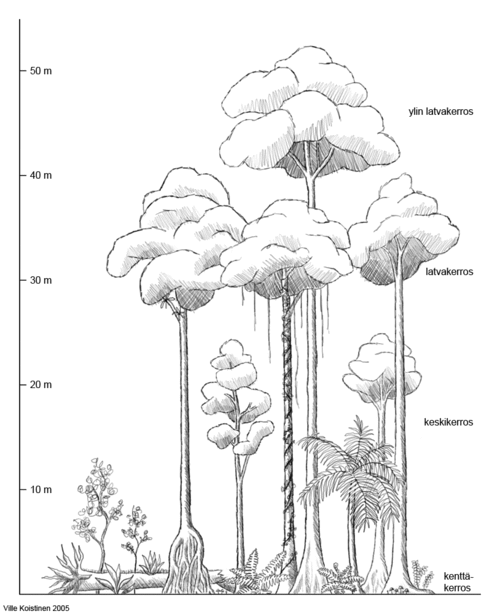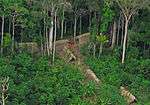Luxuriant vegetation is found in tropical rainforests because of the luxuriant sunlight and rainfall. The characteristics of vegetation here is often tested in examinations and should be studied in detail.
Biomass and Biodiversity
Biomass - the total dry weight of dead organic matter in an area.
Biomass is a measure of the volume of organisms in an area. Imagine you take all the plants in a unit area, kill them, dry them, and weigh them. This is biomass.
Tropical rainforests have large biomass because of the abundant rainfall and sunlight.
Biodiversity - the variety of plant and animal species in an areas
A species is a type of animal, e.g. dog, cat, cattle, sheep. The more species we can find in a unit area, the higher the biodiversity. In tropical rainforests, the biodiversity is the largest among all the biomes. There are several reasons leading to this:
- Abundant sunlight and rainfall is present.
- Interspecies competition occurs. Different organisms in tropical rainforests compete for different resources. In the end, the resources may be divided, e.g. Animal A takes Shelter A and Animal B takes Shelter B. (This is not biology, so we will not go into details.)
- The tropical rainforest provides a diverse range of habitats as the vegetation is stratified (see below).
Stratification of Vegetation

The tropical rainforest is divided into five strata, each with its own characteristics. (Refer to the figure on the right.)
- Emergent layer: The highest layer, 40-50 m above the ground. Trees are widely spaced.
- Canopy layer: The second layer, 30-40 m above the ground. Trees are continuous.
- Understorey/Young tree layer: The third layer, 20-30 m above the ground. Tree seedlings of the above layers are sparse.
- Shrub layer: The fourth layer, 10-20 m above the ground. Shrubs and tree seedlings of the above layers are sparse.
- Undergrowth: The bottom layer, on the forest floor. Ferns, fungi, etc., are sparse.
Vegetation Characteristics
There are numerous vegetation characteristics to be memorised:
| Layer | Characteristic | Explanation |
|---|---|---|
| General | Evergreen[1] - no seasonal pattern in defoliation, new leaves quickly replace shed leaves; no seasonal pattern in flowering or fruiting | No seasonal pattern in insolation or rainfall |
| General | Low root-to-shoot ratio (1:4 to 1:5)/High shoot-to-root ratio(4:1 to 5:1) - Most of the biomass storage is in the above-ground part, little biomass in roots | Infertile soil, abundant insolation above the ground |
| General | Cauliflory - trunk flowers and fruits are found on the trunk and main branches | Pollination by wind is impossible, so they are made accessible to pollinators[2] (insects who can pollinate the trunk) and animals which can eat the fruit |
| General | Broad leaves | Absorb more sunlight |
| General | Waxy leaves with drip-tips | Quickly shed rainwater when needed (high annual rainfall...). If the crown does not quickly shed rainwater, it may become too heavy because of the intercepted water, the leaves may be infected, and the water may inhibit sunlight penetration. |
| General | Thin bark | No need to protect the tree from the cold, facilitate transpiration |
| General | Smooth bark | Prevent lianas (see below) from climbing, shed water quickly |
| General | Shallow roots | All nutrients are concentrated on the topsoil, so shallow roots can absorb them more efficiently |
| Emergent | Wide, umbrella-shaped crowns[3] | Absorb more sunlight, space is abundant |
| Emergent | Discontinuous, widely-spaced crowns | Absorb more sunlight |
| Emergent, Canopy | Straight trunks | Support the plants |
| Emergent, Canopy | Buttress roots - roots that extend laterally, up to 4 m high | Absorb nutrients from a larger area, support the tree's great weight |
| Emergent, Canopy | Tall branches, appearing only on the top third of the trunk | Absorb more sunlight |
| Emergent, Canopy | Lighter leaves | It is easier to absorb sunlight on the emergent and canopy layers, so they have less chlorophyll |
| Emergent, Canopy | Heliophytes (sun-loving plants) | More sunlight is available |
| Canopy | Rounded, oval-shaped crowns | Absorb more sunlight |
| Canopy | Continuous crowns | Absorb more sunlight |
| Canopy, Understorey (near rivers and streams) | Stilt roots | Support the trees |
| Understorey | Darker leaves | Absorb more sunlight with more chlorophyll |
| Understorey | Narrower crowns | Less sunlight available, so growth is hindered |
| Understorey | Slim trunks | Less support is needed |
| Understorey, shrub, undergrowth | Sparse vegetation | Insufficient sunlight for growth, relative humidity is too high and this hinders tranpiration |
| Shrub, undergrowth | Skiophytes (shade-loving plants) such as fungi, ferns | Less sunlight is available |
Vegetation Types
- Woody plants, including trees and woody shrubs, are found. They are heliophytes (sun-loving plants) who take advantage of the large amount of insolation.
- Ferns and fungi are skiophytes which grow well in the dark.
- Some plants rely on other plants (which are their hosts):
- Climbers grow on tall trees for physical support. They start at ground level, hook onto and climb along their hosts, and reach the canopy layer. They may spread to other trees to maximise the amount of sunlight received. Lianas are an example.
- Epiphytes are small shrubs or herbs that attach themselves on tree trunks or branches. They do not have roots in the soil, and have aerial roots that capture moisture from the air. They can then grow in the canopy layer and capture sunlight. They are harmless to their hosts.
- Stranglers/Strangler figs are the transitional species between lianas and epiphytes. They send their roots to the ground and surround the host trees. They grow rapidly and soon cover the crown of the hosts, blocking out their sunlight. The host will die so the strangler can inherit its place in the canopy.
- Parasites grow directly on their hosts, and absorb nutrients from them. Large amounts of litter in tropical rainforests provides a nutritious environment for parasites. Rafflesia is an example.
| |||||||||||||||||||
